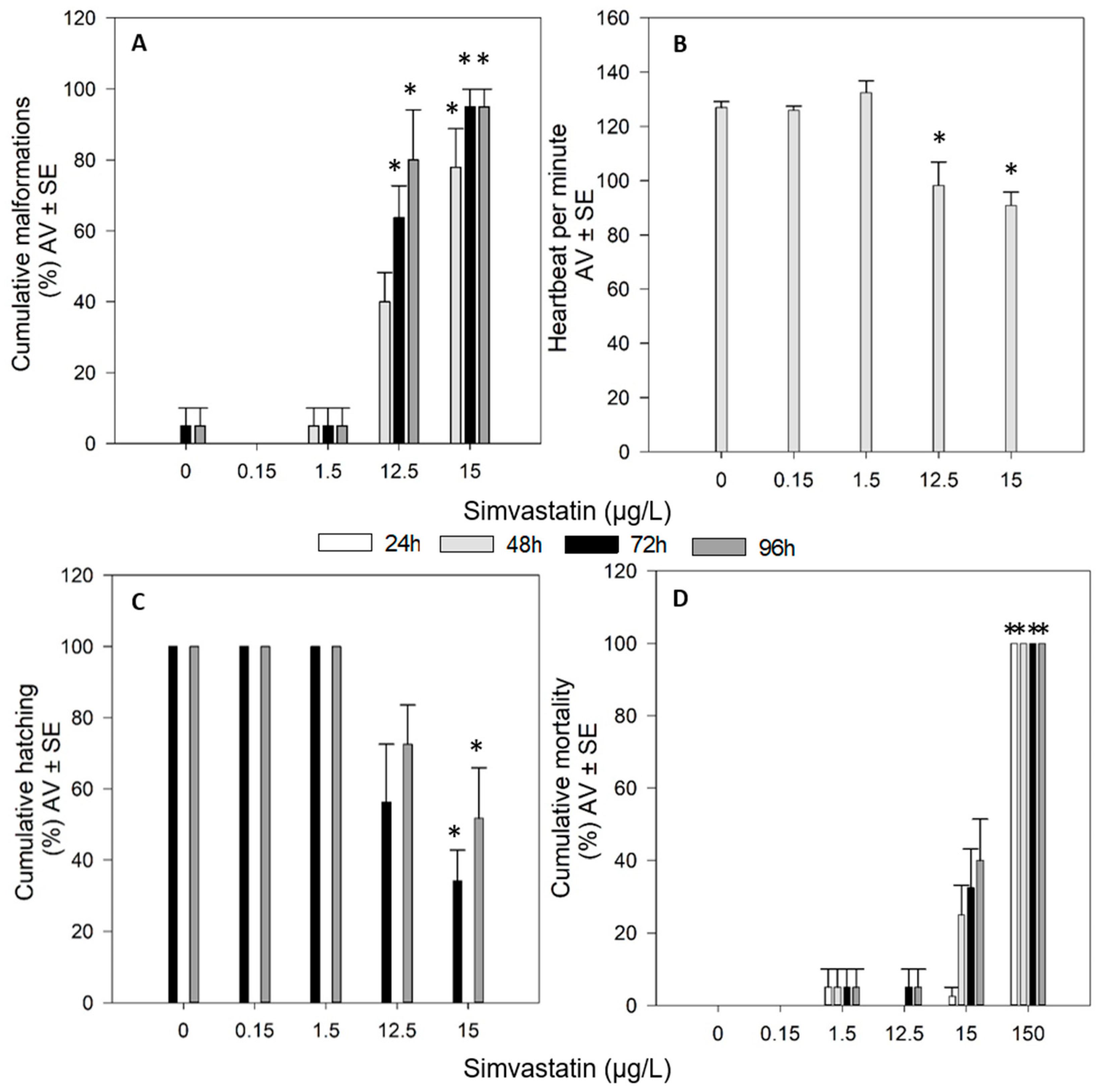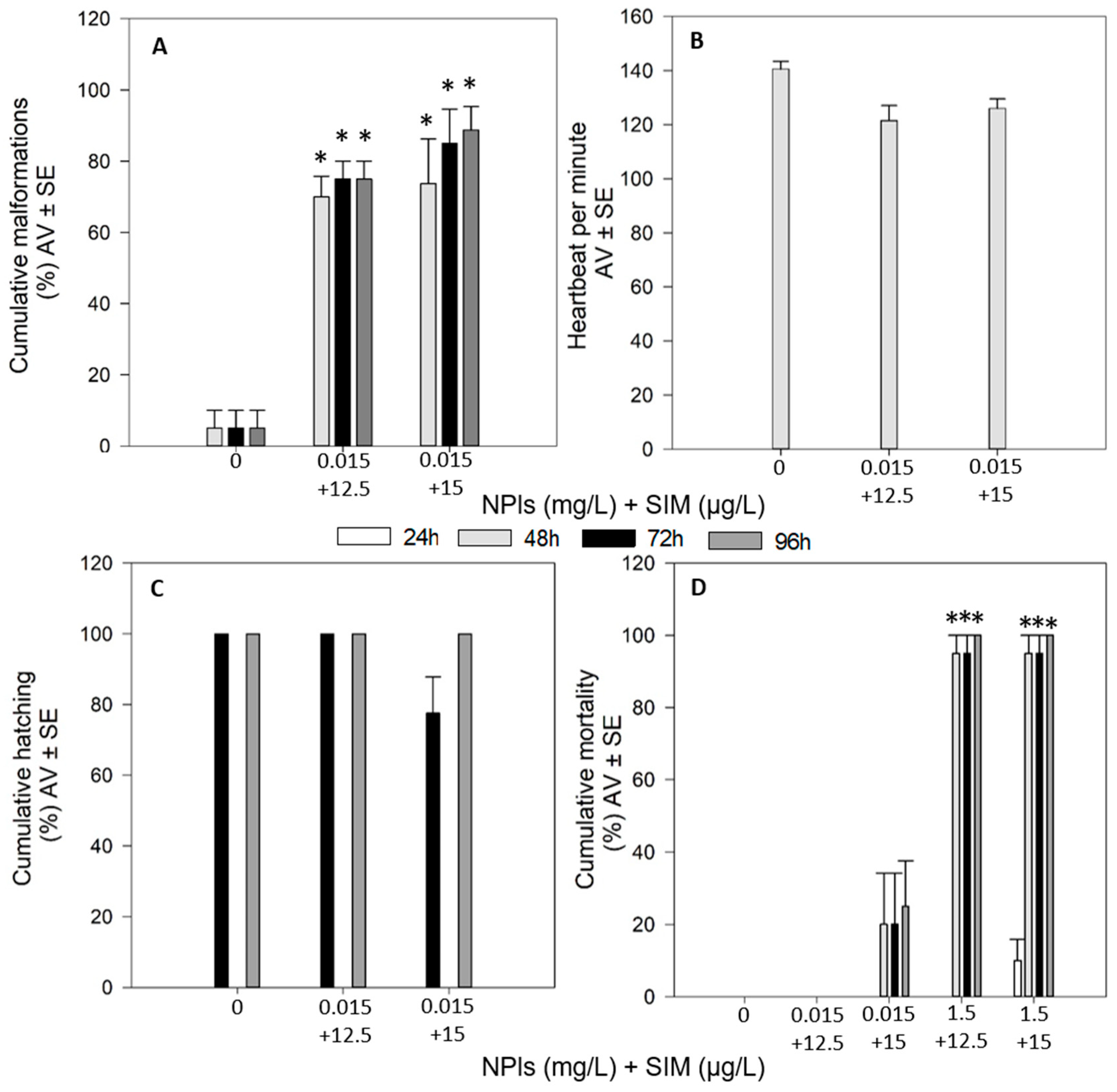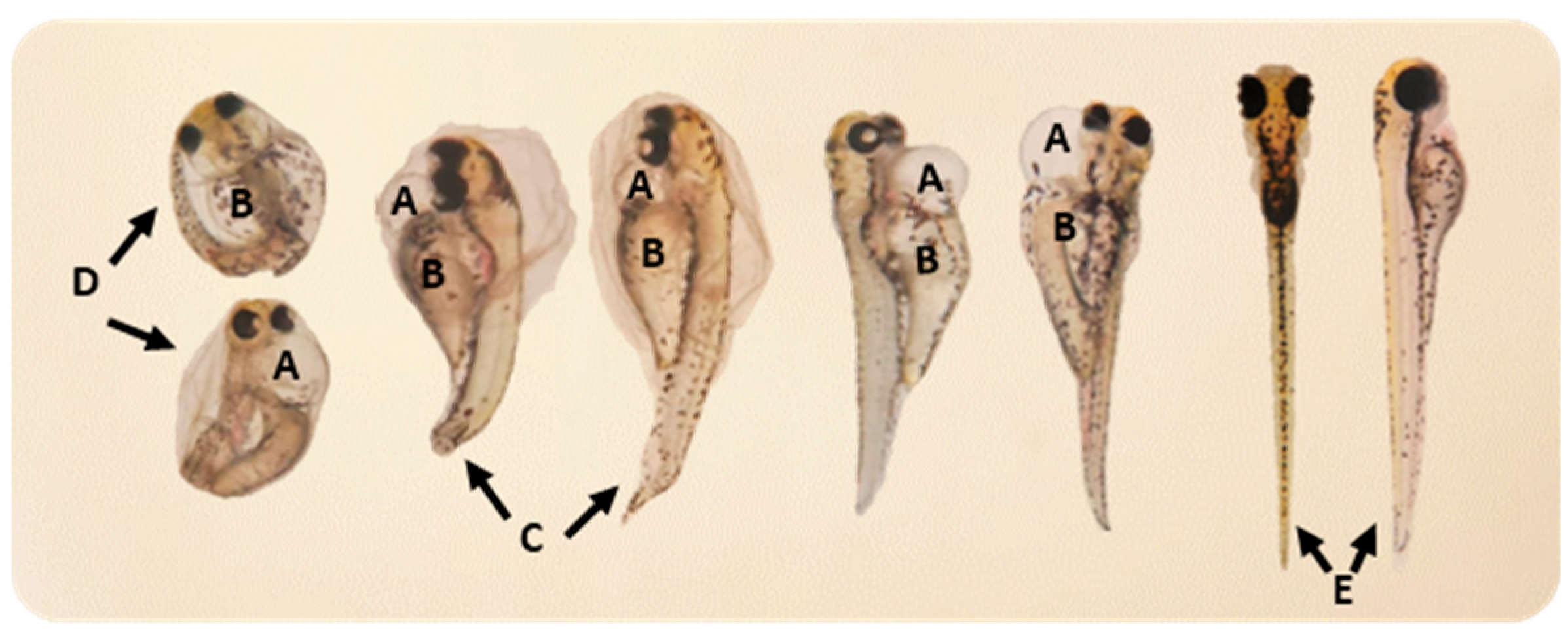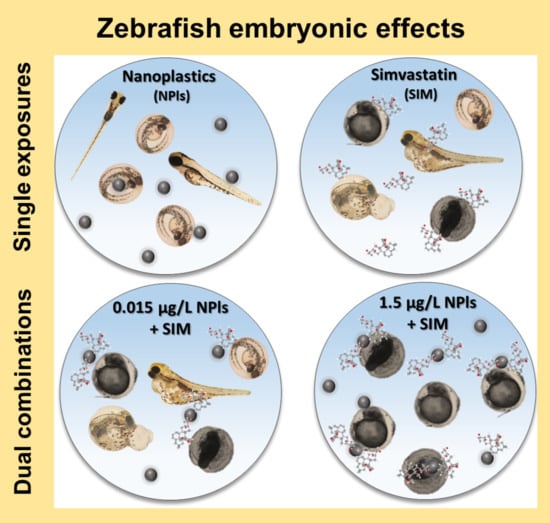Polystyrene Nanoplastics Can Alter the Toxicological Effects of Simvastatin on Danio rerio
Abstract
1. Introduction
2. Materials and Methods
2.1. Test Organism
2.2. Preparation and Characterization of Nanoplastics
2.3. Fish Assays
2.4. Statistical Analysis
3. Results
3.1. Characterization of Nanoplastics Alone and with Simvastatin
3.2. Effects of Single Exposures
3.2.1. Effects of Nanoplastics
3.2.2. Effects of Simvastatin
3.3. Effects of Combined Exposures Nanoplastics and Simvastatin
4. Discussion
5. Conclusions
Supplementary Materials
Author Contributions
Funding
Institutional Review Board Statement
Data Availability Statement
Acknowledgments
Conflicts of Interest
References
- Chen, Q.; Gundlach, M.; Yang, S.; Jiang, J.; Velki, M.; Yin, D.; Hollert, H. Quantitative investigation of the mechanisms of microplastics and nanoplastics toward zebrafish larvae locomotor activity. Sci. Total Environ. 2017, 584–585, 1022–1031. [Google Scholar] [CrossRef]
- Gigault, J.; Ter Halle, A.; Baudrimont, M.; Pascal, P.-Y.; Gauffre, F.; Phi, T.-L.; El Hadri, H.; Grassl, B.; Reynaud, S. Current opinion: What is a nanoplastic? Environ. Pollut. 2018, 235, 1030–1034. [Google Scholar] [CrossRef] [PubMed]
- Chen, Q.; Yin, D.; Jia, Y.; Schiwy, S.; Legradi, J.; Yang, S.; Hollert, H. Enhanced uptake of BPA in the presence of nanoplastics can lead to neurotoxic effects in adult zebrafish. Sci. Total Environ. 2017, 609, 1312–1321. [Google Scholar] [CrossRef] [PubMed]
- Pitt, J.A.; Trevisan, R.; Massarsky, A.; Kozal, J.S.; Levin, E.D.; Di Giulio, R.T. Maternal transfer of nanoplastics to offspring in zebrafish (Danio rerio): A case study with nanopolystyrene. Sci. Total Environ. 2018, 643, 324–334. [Google Scholar] [CrossRef]
- Lee, W.S.; Cho, H.-J.; Kim, E.; Huh, Y.H.; Kim, H.-J.; Kim, B.; Kang, T.; Lee, J.-S.; Jeong, J. Bioaccumulation of polystyrene nanoplastics and their effect on the toxicity of Au ions in zebrafish embryos. Nanoscale 2019, 11, 3173–3185. [Google Scholar] [CrossRef] [PubMed]
- Koelmans, A.A.; Besseling, E.; Shim, W.J. Nanoplastics in the Aquatic Environment. Critical Review. In Marine Anthropogenic Litter; Springer International Publishing: Cham, Switzerland, 2015; pp. 325–340. [Google Scholar]
- Science Advice for Policy by European Academies a Scientific Perspective on Microplastics in Nature and Society. 2019. Available online: https://www.sapea.info/wp-content/uploads/report.pdf (accessed on 24 September 2020).
- Strungaru, S.-A.; Jijie, R.; Nicoara, M.; Plavan, G.; Faggio, C. Micro- (nano) plastics in freshwater ecosystems: Abundance, toxicological impact and quantification methodology. TrAC Trends Anal. Chem. 2019, 110, 116–128. [Google Scholar] [CrossRef]
- Brandts, I.; Teles, M.; Gonçalves, A.P.; Barreto, A.; Franco-Martinez, L.; Tvarijonaviciute, A.; Martins, M.A.; Soares, A.M.V.M.; Tort, L.; Oliveira, M. Effects of nanoplastics on Mytilus galloprovincialis after individual and combined exposure with carbamazepine. Sci. Total Environ. 2018, 643, 775–784. [Google Scholar] [CrossRef]
- Pitt, J.A.; Kozal, J.S.; Jayasundara, N.; Massarsky, A.; Trevisan, R.; Geitner, N.; Wiesner, M.; Levin, E.D.; Di Giulio, R.T. Uptake, tissue distribution, and toxicity of polystyrene nanoparticles in developing zebrafish (Danio rerio). Aquat. Toxicol. 2018, 194, 185–194. [Google Scholar] [CrossRef]
- Parenti, C.C.; Ghilardi, A.; Della Torre, C.; Magni, S.; Del Giacco, L.; Binelli, A. Evaluation of the infiltration of polystyrene nanobeads in zebrafish embryo tissues after short-term exposure and the related biochemical and behavioural effects. Environ. Pollut. 2019, 254, 112947. [Google Scholar] [CrossRef] [PubMed]
- Kashiwada, S. Distribution of nanoparticles in the see-through medaka (Oryzias latipes). Environ. Health Perspect. 2006, 114, 1697–1702. [Google Scholar] [CrossRef] [PubMed]
- Van Pomeren, M.; Brun, N.R.; Peijnenburg, W.J.G.M.; Vijver, M.G. Exploring uptake and biodistribution of polystyrene (nano)particles in zebrafish embryos at different developmental stages. Aquat. Toxicol. 2017, 190, 40–45. [Google Scholar] [CrossRef]
- Brun, N.R.; van Hage, P.; Hunting, E.R.; Haramis, A.P.G.; Vink, S.C.; Vijver, M.G.; Schaaf, M.J.M.; Tudorache, C. Polystyrene nanoplastics disrupt glucose metabolism and cortisol levels with a possible link to behavioural changes in larval zebrafish. Commun. Biol. 2019, 2. [Google Scholar] [CrossRef]
- Trevisan, R.; Voy, C.; Chen, S.; Di Giulio, R.T. Nanoplastics Decrease the Toxicity of a Complex PAH Mixture but Impair Mitochondrial Energy Production in Developing Zebrafish. Environ. Sci. Technol. 2019, 53, 8405–8415. [Google Scholar] [CrossRef] [PubMed]
- Ribeiro, S.; Torres, T.; Martins, R.; Santos, M.M. Toxicity screening of diclofenac, propranolol, sertraline and simvastatin using Danio rerio and paracentrotus lividus embryo bioassays. Ecotoxicol. Environ. Saf. 2015, 114, 67–74. [Google Scholar] [CrossRef] [PubMed]
- Cunha, V.; Santos, M.M.; Moradas-Ferreira, P.; Castro, L.F.C.; Ferreira, M. Simvastatin modulates gene expression of key receptors in zebrafish embryos. J. Toxicol. Environ. Health Part A Curr. Issues 2017, 80, 465–476. [Google Scholar] [CrossRef]
- Dong, Z.; Senn, D.B.; Moran, R.E.; Shine, J.P. Prioritizing environmental risk of prescription pharmaceuticals. Regul. Toxicol. Pharmacol. 2013, 65, 60–67. [Google Scholar] [CrossRef]
- Pereira, A.M.P.T.; Silva, L.J.G.; Meisel, L.M.; Lino, C.M.; Pena, A. Environmental impact of pharmaceuticals from Portuguese wastewaters: Geographical and seasonal occurrence, removal and risk assessment. Environ. Res. 2015, 136, 108–119. [Google Scholar] [CrossRef]
- Pereira, A.M.P.T.; Silva, L.J.G.; Laranjeiro, C.S.M.; Meisel, L.M.; Lino, C.M.; Pena, A. Human pharmaceuticals in Portuguese rivers: The impact of water scarcity in the environmental risk. Sci. Total Environ. 2017, 609, 1182–1191. [Google Scholar] [CrossRef]
- Almeida, M.; Martins, M.A.; Soares, A.M.V.; Cuesta, A.; Oliveira, M. Polystyrene nanoplastics alter the cytotoxicity of human pharmaceuticals on marine fish cell lines. Environ. Toxicol. Pharmacol. 2019, 69, 57–65. [Google Scholar] [CrossRef] [PubMed]
- Neuparth, T.; Martins, C.; Carmen, B.; Costa, M.H.; Martins, I.; Costa, P.M.; Santos, M.M. Hypocholesterolaemic pharmaceutical simvastatin disrupts reproduction and population growth of the amphipod Gammarus locusta at the ng/L range. Aquat. Toxicol. 2014, 155, 337–347. [Google Scholar] [CrossRef]
- Barros, S.; Montes, R.; Quintana, J.B.; Rodil, R.; André, A.; Capitão, A.; Soares, J.; Santos, M.M.; Neuparth, T. Chronic environmentally relevant levels of simvastatin disrupt embryonic development, biochemical and molecular responses in zebrafish (Danio rerio). Aquat. Toxicol. 2018, 201, 47–57. [Google Scholar] [CrossRef]
- Patibandla, S.; Jiang, J.-Q.; Shu, X. Toxicity assessment of four pharmaceuticals in aquatic environment before and after ferrate (VI) treatment. J. Environ. Chem. Eng. 2018, 6, 3787–3797. [Google Scholar] [CrossRef]
- Liu, Y.; Ding, R.; Pan, B.; Wang, L.; Liu, S.; Nie, X. Simvastatin affect the expression of detoxification-related genes and enzymes in Daphnia magna and alter its life history parameters. Ecotoxicol. Environ. Saf. 2019, 182, 109389. [Google Scholar] [CrossRef]
- Campos, L.M.; Rios, E.A.; Guapyassu, L.; Midlej, V.; Atella, G.C.; Herculano-Houzel, S.; Benchimol, M.; Mermelstein, C.; Costa, M.L. Alterations in zebrafish development induced by simvastatin: Comprehensive morphological and physiological study, focusing on muscle. Exp. Biol. Med. 2016, 241, 1950–1960. [Google Scholar] [CrossRef]
- Wang, C.; Ku, P.; Nie, X.; Bao, S.; Wang, Z.; Li, K. Effects of simvastatin on the PXR signaling pathway and the liver histology in Mugilogobius abei. Sci. Total Environ. 2019, 651, 399–409. [Google Scholar] [CrossRef] [PubMed]
- Campos, L.M.; Rios, E.A.; Midlej, V.; Atella, G.C.; Herculano-Houzel, S.; Benchimol, M.; Mermelstein, C.; Costa, M.L. Structural Analysis of Alterations in Zebrafish Muscle Differentiation Induced by Simvastatin and Their Recovery with Cholesterol. J. Histochem. Cytochem. 2015, 63, 427–437. [Google Scholar] [CrossRef]
- OECD Test Number 210: Fish, Early-Life Stage Toxicity Test; Organisation for Economic Co-Operation and Development (OECD), Guidelines for the Testing of Chemicals, Section 2; OECD Publishing: Paris, France, 2013. [CrossRef]
- Al-Sid-Cheikh, M.; Rowland, S.J.; Stevenson, K.; Rouleau, C.; Henry, T.B.; Thompson, R.C. Uptake, Whole-Body Distribution, and Depuration of Nanoplastics by the Scallop Pecten maximus at Environmentally Realistic Concentrations. Environ. Sci. Technol. 2018, 52, 14480–14486. [Google Scholar] [CrossRef] [PubMed]
- OECD Guidance Document on Aquatic Toxicity Testing of Difficult Substances and Mixtures; OECD Series on Testing and Assessment; OECD Publishing: Paris, France, 2019. [CrossRef]
- Walkey, C.D.; Chan, W.C.W. Understanding and controlling the interaction of nanomaterials with proteins in a physiological environment. Chem. Soc. Rev. 2012, 41, 2780–2799. [Google Scholar] [CrossRef]
- Galloway, T.S.; Cole, M.; Lewis, C. Interactions of microplastic debris throughout the marine ecosystem. Nat. Ecol. Evol. 2017, 1, 116. [Google Scholar] [CrossRef] [PubMed]
- Lee, H.; Shim, W.J.; Kwon, J.H. Sorption capacity of plastic debris for hydrophobic organic chemicals. Sci. Total Environ. 2014, 470–471, 1545–1552. [Google Scholar] [CrossRef]
- Wang, J.; Tan, Z.; Peng, J.; Qiu, Q.; Li, M. The behaviors of microplastics in the marine environment. Mar. Environ. Res. 2016, 113, 7–17. [Google Scholar] [CrossRef]





| Size of PS NPls | Development Stage | Exposure Characteristics | Assessed Endpoints | Main Findings | Ref. |
|---|---|---|---|---|---|
| 47 nm | Adult | Waterborne exposure 1 mg·L−1 3 days Co-exposure: Bisphenol A (BPA) | Dopamine content Acetylcholinesterase (AChE) activity NPls quantification Gene/protein expression | NPls accumulated in various tissues. Inhibited AChE activity but not at the co-exposure. NPls caused myelin basic protein/gene up-regulation. Co-exposure increased the BPA uptake. | [3] |
| 47 nm Microplastics (MPls; 41 µm) | Embryo | Waterborne exposure 1 mg·L−1 120 hours (h) Co-exposure: 17 α-ethynylestradiol | Locomotor activity Body length Gene expression Antioxidant system AChE activity NPls quantification | NPls alone and co-exposure induced hypoactivity. Reduced the body larvae length. NPls caused gene upregulation. Decreased AChE activity and reduced glutathione content. | [1] |
| 50, 200 and 500 nm | Embryo | Waterborne exposure 0.1 mg·mL−1 6, 24 and 96 h Co-exposure: Chloroauric acid (HAuCl4) | Mortality Edemas Hatching Cell death Reactive oxygen species (ROS) Gene expression NPls accumulation | Smaller NPls readily penetrated the chorion and accumulated throughout the whole body. NPls induced only marginal effects, but the HAuCl4 synergistically exacerbated these effects in a dose and size dependent manner. | [5] |
| 32 and 35 nm | Embryo and adult | Exposure via food 1 mg/fish gram 1 week | Reproduction Antioxidant system Mitochondrial function General physiology NPls distribution Locomotor activity | NPls modified the antioxidant system. Accumulated in the yolk sac. NPls transferred from mothers to offspring. | [4] |
| 500 nm | Embryo | Waterborne exposure 1 mg·L−1 48 h | NPls ingestion and tissue infiltration Protein carbonylation Antioxidant/detoxifying enzymes activities Swimming behavior | NPls infiltrated tissues. Decreased enzymatic activities. Altered the locomotor behaviour. | [11] |
| 35 nm | Embryo | Waterborne exposure 0.1, 1 and 10 ppm 120 h | General physiology NPls uptake and distribution Locomotor activity Oxygen consumption | NPls accumulated in the yolk sac and migrated to other organs. Decreased the heartbeat rate and altered behavior. | [10] |
| 27, 50, 217 and 727 nm | Embryo | Waterborne exposure 5, 25 and 50 mg·L−1 48 h | Visualization of adsorbed, ingested or biodistributed NPls Eye width and length | The absorption was dependent on NPls size and time of exposure. | [14] |
| 47 nm | Embryo | Waterborne exposure 0.1, 1 and 10 ppm 24, 48 and 96 h Co-exposure: Polycyclic aromatic hydrocarbons (PAHs) | Heartbeat rate Enzymatic activity Blood vessel formation Mitochondrial bioenergetics | NPls decreased the developmental deformities and impaired vascular development caused by PAHs. NPls decreased the mitochondrial coupling efficiency. NPls suggested sorbing PAHs and decreasing their uptake. | [15] |
| 19 nm | Embryo | Waterborne exposure 0.2, 2 and 20 mg·L−1 48 h | NPls distribution General physiology Cortisol and glucose levels Gene expression Larval behavior | NPls accumulated in various tissues. Affected swim bladder development. Increased cortisol and decreased glucose levels. NPls induced hyperactivity. | [13] |
| Nanoplastics | Hydrodynamic Size (nm) | Zeta Potential (mV) | ||
|---|---|---|---|---|
| 0 h | 96 h | 0 h | 96 h | |
| Stock dispersion | 69 | 69 | −29 | −29 |
| In test media (without organisms) | 66 | 66 | −25 | −25 |
| In test media (with organisms) | 68 | 294 | −26 | −23 |
| In test media (with SIM) | 77 | 305 | −12 | −12 |
| Endpoints | EC50 (µg/L) | ||
|---|---|---|---|
| SIM | SIM + 0.015 NPls | SIM + 1.5 NPls | |
| Survival | 15.39 ± 0.36 | 15.33 ± 25.07 | 6.93 ± 5.60 |
| Malformations | 9.71 ± 1.44 | 9.79 ± 2.09 | n.d. |
| Hatching | 13.96 ± 0.33 | 15.05 ± 8.86 | n.d. |
| Heartbeat | 19.71 ± 2.15 | 27.29 ± 7.13 | n.d. |
| Time Exposure | Experimental Conditions | |||||||
|---|---|---|---|---|---|---|---|---|
| 0.015 NPls | 1.5 NPls | 12.5 SIM | 15 SIM | 0.015 NPls + 12.5 SIM | 0.015 NPls + 15 SIM | 1.5 NPls + 12.5 SIM | 1.5 NPls + 15 SIM | |
| Cumulative Mortality (%) | ||||||||
| 24 h | 15.0 ± 5.0 | 15.0 ± 9.6 | 0.0 ± 0.0 | 2.5 ± 2.5 | 0.0 ± 0.0 | 0.0 ± 0.0 | 0.0 ± 0.0 | 10.0 ± 5.8 |
| 48 h | 15.0 ± 5.0 | 20.0 ± 8.2 | 0.0 ± 0.0 | 25.0 ± 8.2 | 0.0 ± 0.0 | 20.0 ± 14.1 | 95.0 ± 5.0 *#S | 95.0 ± 5.0 * |
| 72 h | 15.0 ± 5.0 | 20.0 ± 8.2 | 5.0 ± 5.0 | 32.5 ± 10.6 | 0.0 ± 0.0 | 20.0 ± 14.1 | 95.0 ± 5.0 * | 95.0 ± 5.0 * |
| 96 h | 20.0 ± 8.2 | 20.0 ± 8.2 | 5.0 ± 5.0 | 40.0 ± 11.3 | 0.0 ± 0.0 | 25.0 ± 12.6 | 100.0 ± 0.0 *#S | 100.0 ± 0.0 * |
| Cumulative Hatching (%) | ||||||||
| 72 h | 93.8 ± 6.3 | 83.3 ± 16.7 | 56.3 ± 16.3 | 34.2 ± 8.6 * | 100.0 ± 0.0 | 77.5 ± 10.3 | n.d. | n.d. |
| 96 h | 100.0 ± 0.0 | 91.7 ± 8.3 | 72.5 ± 11.1 | 51.7 ± 14.2 * | 100.0 ± 0.0 | 100.0 ± 0.0 #S | n.d. | n.d. |
| Heartbeat (per minute) | ||||||||
| 48 h | 131.0 ± 3.1 | 131.6 ± 0.8 | 98.2 ± 4.3 * | 91.0 ± 2.4 * | 122.6 ± 2.8 | 126.0 ± 1.8 #S | n.d. | n.d. |
| Cumulative Malformations (%) | ||||||||
| 48 h | 6.3 ± 6.3 | 0.0 ± 0.0 | 40.0 ± 8.2 | 77.9 ± 10.9 * | 70.0 ± 5.8 #N | 73.8 ± 12.5 *#N | n.d. | n.d. |
| 72 h | 6.3 ± 6.3 | 0.0 ± 0.0 | 63.8 ± 9.0 * | 95.0 ± 5.0 * | 75.0 ± 5.0 *#N | 85.0 ± 9.6 *#N | n.d. | n.d. |
| 96 h | 6.3 ± 6.3 | 8.3 ± 8.3 | 80.0 ± 14.1 * | 95.0 ± 5.0 * | 75.0 ± 5.0 *#N | 88.8 ± 6.6 *#N | n.d. | n.d. |
Publisher’s Note: MDPI stays neutral with regard to jurisdictional claims in published maps and institutional affiliations. |
© 2021 by the authors. Licensee MDPI, Basel, Switzerland. This article is an open access article distributed under the terms and conditions of the Creative Commons Attribution (CC BY) license (http://creativecommons.org/licenses/by/4.0/).
Share and Cite
Barreto, A.; Santos, J.; Amorim, M.J.B.; Maria, V.L. Polystyrene Nanoplastics Can Alter the Toxicological Effects of Simvastatin on Danio rerio. Toxics 2021, 9, 44. https://doi.org/10.3390/toxics9030044
Barreto A, Santos J, Amorim MJB, Maria VL. Polystyrene Nanoplastics Can Alter the Toxicological Effects of Simvastatin on Danio rerio. Toxics. 2021; 9(3):44. https://doi.org/10.3390/toxics9030044
Chicago/Turabian StyleBarreto, Angela, Joana Santos, Mónica J.B. Amorim, and Vera L. Maria. 2021. "Polystyrene Nanoplastics Can Alter the Toxicological Effects of Simvastatin on Danio rerio" Toxics 9, no. 3: 44. https://doi.org/10.3390/toxics9030044
APA StyleBarreto, A., Santos, J., Amorim, M. J. B., & Maria, V. L. (2021). Polystyrene Nanoplastics Can Alter the Toxicological Effects of Simvastatin on Danio rerio. Toxics, 9(3), 44. https://doi.org/10.3390/toxics9030044










